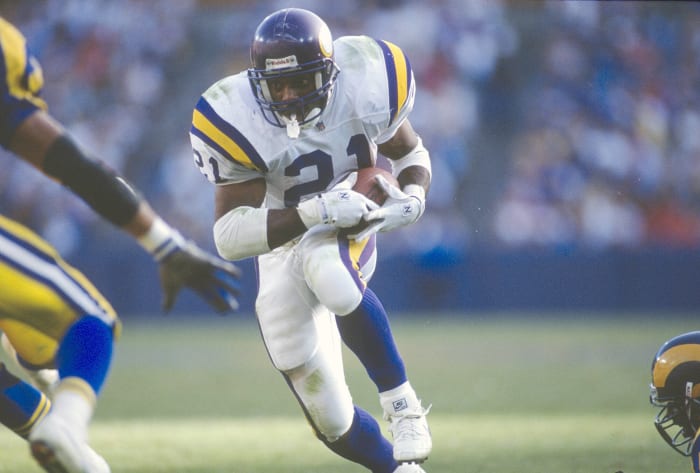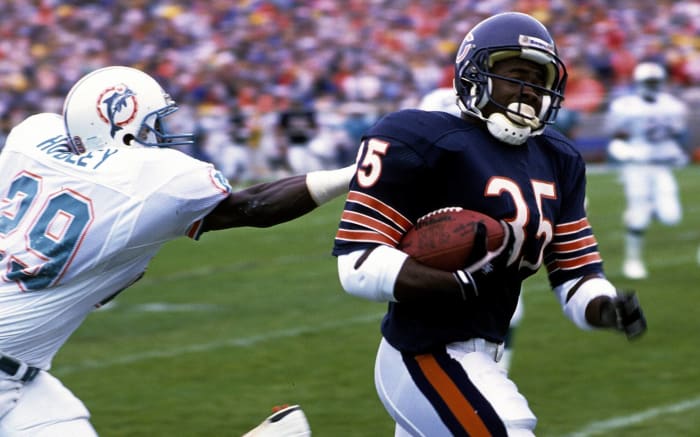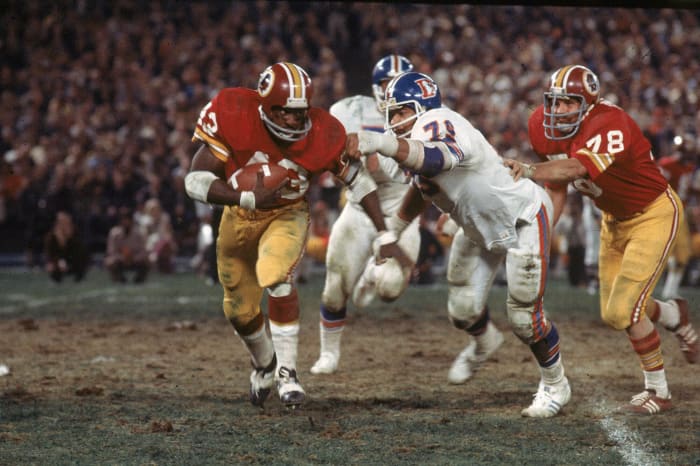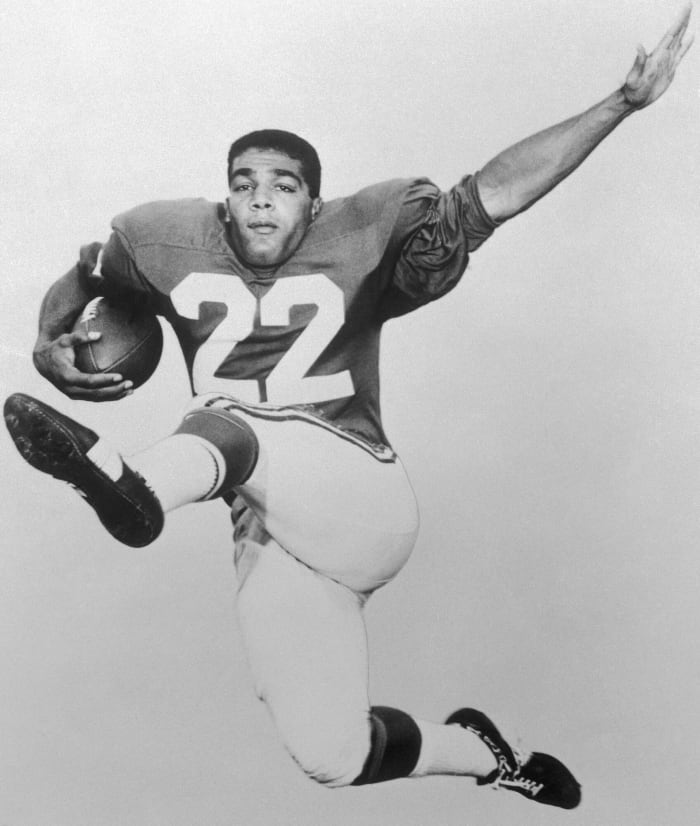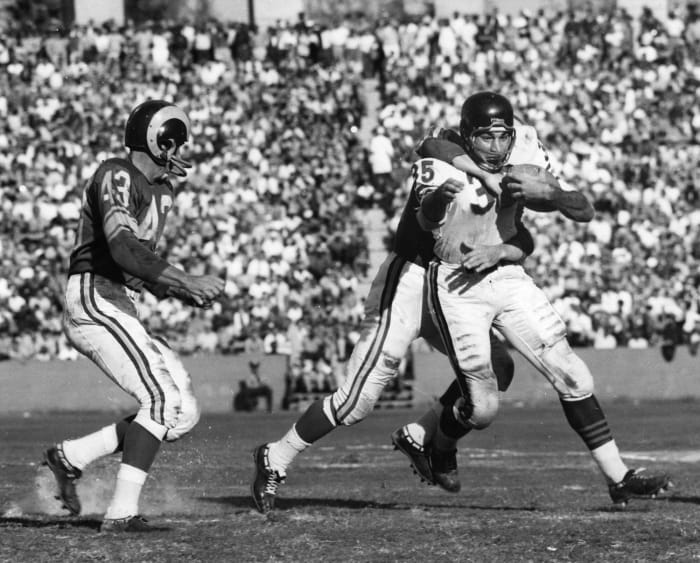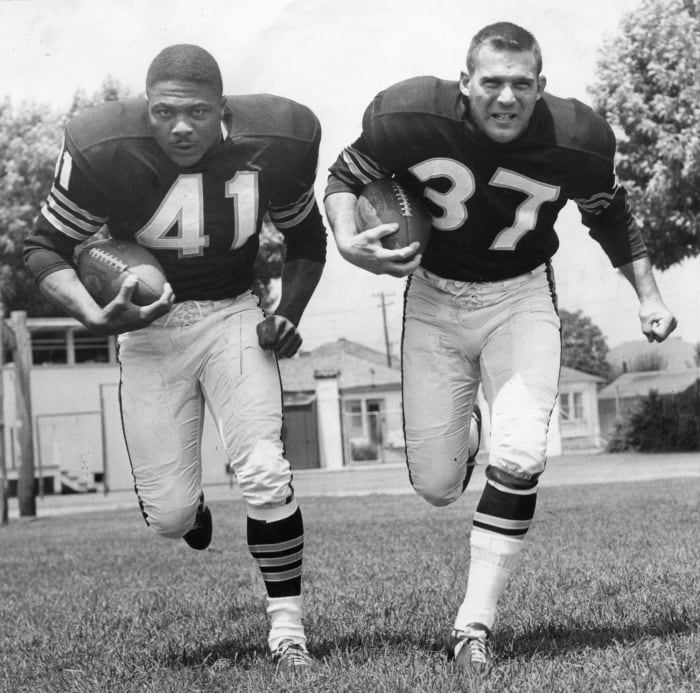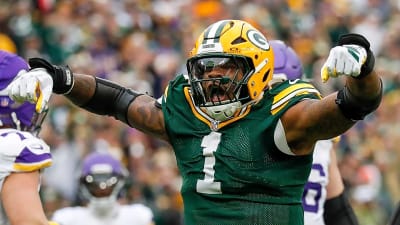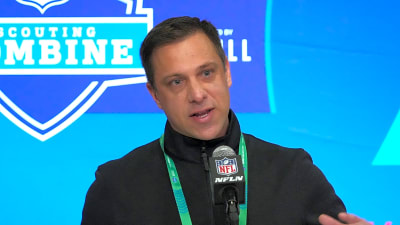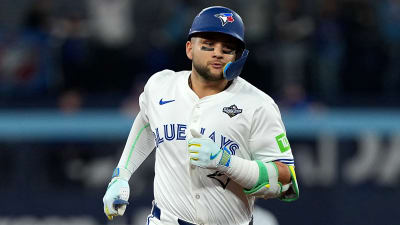With running back value now in question, it feels important to both acknowledge the all-time greats while shining a light on some of the position's producers that lack the recognition of the Hall of Fame-level cogs. These underappreciated backs made key contributions during their respective eras.
Focus on Sport/Getty Images
The top five 1990s rushing yardage leaders include four Hall of Famers and Ricky Watters, who is regarded as one of the top backs not in Canton. No. 6 on the list: Allen, who only played eight 1990s seasons. Drafted in 1990's ninth round, Allen tore both his ACLs as a pro and still tallied four 1,000-yard seasons and started for multiple Vikings playoff teams. Allen tore an ACL in his rookie training camp; two years later, he topped 1,200 yards and scored 15 TDs. He tore the other ACL in 1993. The Clemson alum recovered to play in 48 straight games from 1994-96. In '96 with Washington, Allen led the NFL with 21 TDs, leading to a lucrative re-up with the team.
Ronald C. Modra/Getty Images
Being tapped to replace one of the best to ever do it, Anderson was destined to be underappreciated. The Bears' would-be dynasty decaying as Jim McMahon injuries mounted further cemented Anderson as a cornerstone cog for some less revered Bears teams. But Walter Payton's successor excelled as both a runner and receiver, starting for four playoff-bound Bears squads from 1987-91 and making four Pro Bowls in that span. A player who would have been held in higher regard in a different era, Anderson not only followed Payton but peaked in an era of eye-test monsters like Bo Jackson, Eric Dickerson and Barry Sanders.
Nate Fine/Getty Images
Brown might be overqualified for this list, but if there is a more underappreciated MVP, please name him. The Washington offense's centerpiece as the team transitioned from Sonny Jurgensen to Billy Kilmer in the early 1970s, Brown starred for Vince Lombardi and George Allen. From 1969-73, Brown led the NFL in scrimmage yards The hard-charging back played a central role in Washington advancing to Super Bowl VII, as he beat out Larry Csonka and Earl Morrall for the 1972 MVP award, and was front and center for the team's run of playoff berths in the years that followed. Two bad knees led to Brown's prime ending early.
Bettmann/Getty Images
Playing on mostly down Eagles teams and doing his best work in the years in which Jim Brown cemented his unassailable legacy, Timmy Brown thrived as an Eagles all-purpose weapon. A 27th-round Packers draftee cut after one game in Vince Lombardi's first year, Brown landed with the Eagles via a waiver claim. He finished in the top three in scrimmage yards in 1962, '63 and '65, with only Hall of Fame-bound backs in front of him. In those seasons, the Eagles respectively won three, two and five games. Brown also finished with six return TDs, becoming the first player with two kick-return scores in a game during the 1966 season.
Vic Stein/Getty Images
Casares held the Bears' all-time rushing record until Payton came along, and he offered a borderline-dominant early prime. Part of the fullback's surge included winning the 1956 rushing title, posting 1,126 yards and 14 touchdowns, and powering the Bears to the NFL championship game. That total, coming just before Jim Brown rewrote the record books, ranked second all-time upon completion. The 1954 second-rounder played 12 seasons, received five Pro Bowl nods and contributed on George Halas' final championship squad (1963).
Brian Bahr/Allsport/Getty Images
Listed as a fullback, Centers doubled as a PPR cheat code -- decades before that acronym entered the mainstream. Centers combined for 200 receptions from 1995-96. Even as pass rates have increased over time, Centers still ranks fifth and seventh for most receptions in a season by a running back. Only Christian McCaffrey, Austin Ekeler and Matt Forte have him beat. Centers totaled 962 receiving yards in 1995 and topped 600 in six seasons. His unique receiving skillset helped the Cardinals snap a lengthy playoff drought in 1998 and aided Washington to the NFC East title in '99. Centers played 14 seasons, closing his run with the second-most receiving yards (6,797) in RB history.
Focus on Sport/Getty Images
Contract disputes played a persistent role in Cribbs' career, altering his time in the NFL and USFL. But when on the field in his prime, the elusive Auburn alum shined and led the Bills back to the playoffs. Chuck Knox's ground-oriented approach featured Cribbs, but the Bills also used their starting back as a downfield receiver. Cribbs averaged an astounding 15.1 yards per catch in 1981, totaling seven receiving TDs that year and in 1983. Cribbs, who posted two 1,000-yard rushing years in the USFL from 1984-85, finished with three such seasons in the NFL. He later played a supporting role alongside Roger Craig for two division-winning 49ers teams.
Focus on Sport/Getty Images
The way Bill Belichick cycled through running backs, Cunningham may keep the Patriots' all-time rushing record into a fifth decade. Randall's older brother, Sam Cunningham starred as a Pats fullback for nine seasons. The Patriots motored to the playoffs in 1976, with Cunningham as their lead rusher, but a controversial call saved the favored Raiders. After Cunningham topped 1,000 yards in the NFL's final 14-game season (1977), he led a '78 Pats team to a record that stood 41 years. New England's 3,165 rushing yards in 1978 stood until the Ravens broke it during Lamar Jackson's MVP slate.
Chris Kjobech/MediaNews Group/Oakland Tribune via Getty Images
Daniels carried the Raiders' backfield as the franchise assembled the pieces for historic consistency. Daniels eclipsed 35 carries in just six AFL seasons; he is nevertheless the league's rushing kingpin, with 5,101 yards. A bruising back, Daniels led the AFL in rushing with 1,099 yards in 1963 and topped 800 from 1964-66. But the Raiders also utilized their fullback as a receiver regularly. Daniels used his regular aerial role to catch 24 TD passes and exceed 560 receiving yards in four straight seasons. He finished his AFL career on the 1967 Raiders team that went 13-1, en route to Super Bowl II, but saw his season end early due to a ligament tear.
Jon Adams/Icon Sportswire
Back when running backs hitting their late 20s was not cause for shunning, Davis shined in Washington and Carolina. Davis quietly eclipsed 1,400 rushing yards in 1999 and 2001, helping the '99 squad to an unexpected NFC East crown. Davis signed, gasp, two higher-end contracts -- the first a Washington extension in 2000, the second a free agency deal with the Panthers in '03 -- and was the lead back on Carolina's Super Bowl XXXVIII-bound team. Davis teamed with DeShaun Foster to aid the Jake Delhomme-led attack that year, pushing the Patriots to the brink. A knee injury ended Davis' prime in 2004, but the fourth-round pick accomplished plenty as a pro.
Focus on Sport/Getty Images
Dalvin Cook moved into third place on the Vikings' all-time rushing list, sitting behind Adrian Peterson and Robert Smith. But Foreman meant more to the franchise and helped pry the door open for dual-threat backs. The Vikings made Foreman's aerial skills a regular offensive component, and the 1973 first-rounder shined as a dump-off and downfield option for Fran Tarkenton. The top skill player for three Super Bowl-bound Viking squads, Foreman brought more receiving chops to the table than his higher-regarded peers and dizzied defenders with his spin move. Foreman totaled an NFL-most 79 TDs from 1973-78, counting six in playoff outings.
Chris Kjobech/MediaNews Group/Oakland Tribune via Getty Images
When Garner became Garrison Hearst's placeholder, as the starter missed two seasons due to injury, the 49ers rostered Jerry Rice and Terrell Owens and were trying to replace Steve Young. The Jon Gruden 1.0-era Raiders rostered Rice, Tim Brown, Rod Woodson and a host of aging greats. Both clubs relied on Garner's multipurpose production. A Ricky Watters backup in Philly, Garner did not break out until his age-27 season. The 49ers turned the free agent signing loose as a runner-receiver, In Oakland, Garner threatened to become the NFL's third 1,000-1,000 back. His 900-900 2002 season helped the Raiders to Super Bowl XXXVII.
David Stluka/Icon Sportswire
Bound to be overshadowed on a Brett Favre-centered offense, Green did his best work on good (but not great) Packers teams. The Seahawks trade acquisition took off in the early 2000s, amassing five straight 1,000-yard seasons -- including a Packers-record 1,883-yard 2003. Jamal Lewis and Priest Holmes' stratospheric seasons led to Green not even earning All-Pro acclaim. The NFL has seen 25 1,800-yard rushing seasons. Twenty-three produced first-team All-Pro nods; Green did not even receive second-team recognition. The speedster still kept Packers nuclei largely lacking at wide receiver afloat, teaming with Favre to drive the team to four playoff berths from 2001-04.
George Gojkovich/Getty Images
Peaking when the NFC housed the apex versions of Barry Sanders and Emmitt Smith, Hampton did not have cozy avenues to Pro Bowls. The Giants back nevertheless earned two such honors (1992-93). A backup to Ottis Anderson as a rookie, Hampton did collect a ring. But the 1990 first-rounder produced a grand total of three playoff rushing yards that year. Hampton showed his best stuff during the Giants' regrettable Ray Handley years and during the failed Phil Simms-to-Dave Brown baton pass in the mid-'90s. Hampton amassed five straight 1,000-yard seasons and was the lead skill cog on a 1993 team that saw Smith's defining game deny it home-field advantage.
Focus on Sport/Getty Images
The Chargers, Bills and Oilers aerial producer probably does not come up too often -- save for a crucial end zone drop in a 1989 Bills-Browns shootout -- but Harmon sits third all-time among running backs with 6,076 receiving yards. (Only three backs have more than 5,500.) Harmon played a regular role on Bobby Ross' three Chargers playoff teams from 1992-95. Not used much as a runner, Harmon displayed his chops by hitting 914 receiving yards -- to help the Bolts to a historic turnaround in 1992 -- and surpassed 10 yards per catch in four of his six San Diego seasons. For perspective, Christian McCaffrey and Alvin Kamara have combined for one such season.
Mark Hoffman / Milwaukee Journal Sentinel / USA TODAY NETWORK
Jones has run his count of 1,000-yard rushing seasons to four, with three surpassing 1,100 yards. The career-long NFC North runner has also never finished a season south of 4.5 yards per carry. Jones has all of one Pro Bowl nod to show for this. The former fifth-rounder played a lead role on Packers offenses that helped Aaron Rodgers to back-to-back MVP awards, and he fueled Green Bay's late-season 2023 surge with five straight 100-yard games. After the Pack released their dual threat in 2024, as he declined a second pay cut, he finished with 1,546 scrimmage yards -- second-most in his career -- in a 14-3 Vikings season. Remaining in quality form at 30, Jones has been overlooked.
Hy Peskin/Getty Images
An AFL star, Lincoln twice finished in the top five in MVP voting. While Lance Alworth and the Chargers' QBs are best remembered as the drivers of Sid Gillman's cutting-edge 1960s offense, Lincoln cemented the franchise's only championship with a stunning performance that likely goes overlooked due to it happening in the pre-Super Bowl era. As the Chargers decimated the Patriots 51-10 in the 1963 AFL title game, Lincoln rushed for 206 yards and added 123 receiving. Only one player -- Washington's Timmy Smith -- has even surpassed 200 rushing yards in a league decider. Lincoln's 20-touch, 329-yard outing has no parallel and deserves more attention.
18 of 26
Lawrence McCutchen
Focus on Sport/Getty Images
The Rams stood as the NFC's third 1970s contender staple, alongside the Cowboys and Vikings. While Roger Staubach and Fran Tarkenton powered those storied teams, the Rams cycled through a host of QBs well off the Hall of Fame level. This left McCutchen as one of the NFL's most important weapons, and the efficient back boosted the Rams to seven straight division titles. McCutcheon finished as a top-five rusher four times from 1973-77 and broke Steve Van Buren's playoff record with 202 yards in a 1975 divisional-round win over the Cardinals. The platter of QBs McCutcheon enjoyed left the Rams short of a title, but the five-time Pro Bowl RB held up his part of the deal.
Ronald C. Modra/Getty Images
McNeil retired as the Jets' all-time and single-game rushing leader; Curtis Martin eclipsed both marks en route to the Hall of Fame. This Jets era in general is a bit underappreciated as well, seeing as it produced a number of playoff cameos but no Super Bowl. The 1981 No. 3 overall pick, McNeil was one of the early- and mid-1980s' best backs. His top season came in the 1982 strike-shortened slate. After going for an NFL-high 786 yards in nine games, McNeil shredded the defending AFC champion Bengals for 202 in Round 1. The three-time Pro Bowler was the offensive centerpiece for the New York Sack Exchange teams and played 12 Jets seasons.
Focus on Sport/Getty Images
Mitchell and Bert Jones led the way in the Baltimore Colts' final surge. While said rise came at a time in which the Steelers and Raiders had assembled historically dominant teams, Mitchell made his mark. The AFC's Chuck Foreman in this era, Mitchell thrived as a runner and a receiver for the mid-'70s Baltimore teams, leading the NFL in receptions in 1974 and '77, and topping 1,700 scrimmage yards in three straight 14-game seasons. The latter two years drew second-team All-Pro acclaim. After the "Ghost to the Post" loss, Mitchell and the Colts battled over his contract. A 1978 trade to San Diego did not extend the versatile talent's prime.
Focus on Sport/Getty Images
One of two Pruitts to lead the Browns' backfield, including the unrelated Greg, Mike Pruitt also played for a team that already deployed two Hall of Famers at this position. Leroy Kelly made it to Canton after succeeding the best to ever do it, and Jim Brown's shadow perpetually lingers for Browns backs. Pruitt held his own in the late 1970s and early '80s, posting four 1,000-yard seasons and teaming with 1980 MVP Brian Sipe on the "Kardiac Kids" squad. The 1982 players' strike impeded a fifth 1,000-yard slate, but the 1976 first-round pick made a nice impression after Greg Pruitt's knee injury created an opportunity.
Focus on Sport/Getty Images
Sims receives his due, for the most part. But seeing as his career ended after five seasons and another Lions No. 20 quickly surpassed him, it is worth acknowledging the spectacular talents of 1980's No. 1 overall pick. Sims' 85.1 rushing yards per game rank eighth all-time, and he got there during one of the Lions' many unremarkable periods. That said, Sims' brilliance powered a QB-deficient Detroit squad to the playoffs in 1983, when his 114-yard rushing day helped the Lions scare the 49ers despite a five-INT day from Gary Danielson. Sims was on a Hall of Fame track before a career-ending 1984 knee injury.
Focus on Sport/Getty Images
For Millennials and younger, "The Replacements" likely evokes memories of the mediocre Keanu Reeves vehicle rather than the alt-rock indie darlings of the 1980s. Like the Paul Westerberg-fronted band, Warner saw a turn-of-the-century development affect his legacy. Kurt Warner started in three Super Bowls and became a Hall of Famer. Nearly two decades earlier, Curt Warner shined as a Steve Largent copilot in driving the Seahawks to playoff brackets. Warner lifted Seattle to the 1983 AFC title game as a rookie and, after a severe knee injury in '84, returned and delivered three more 1,000-yard seasons.
Focus on Sport/Getty Images
Nearly 40 years later, Wilder's single-season touch record (492) remains. Modern RB usage points to it staying in perpetuity. The 1981 second-rounder was effective during one of the worst runs in NFL history, with the Bucs going 14 seasons (1983-96) without a winning record. Wilder pushed single-season rushing kingpin Eric Dickerson for the 1984 scrimmage yards title, finishing with 2,229 (to Dickerson's 2,244). For a 2-14 team the next year, Wilder topped 1,600. The Bucs' effort to replace him with Bo Jackson in 1986 backfired spectacularly, and the team's ineptitude instead limited Wilder in the late '80s. But the Mizzou alum remains Tampa Bay's all-time rushing leader.
25 of 26
John L. Williams
Focus on Sport/Getty Images
Slotted as Warner's lead blocker to start his career, Williams did his best work as the halfback's prime waned. Warner and Williams combined for 1,902 rushing yards in 1988 to help the Seahawks claim their first AFC West title, but the undersized fullback offered more versatility. He added 651 receiving yards that season and, with Warner gone by 1990, delivered back-to-back Pro Bowl showings in Chuck Knox's final two seasons. On non-playoff-bound Seattle teams from 1990-91, Williams combined for more than 2,600 scrimmage yards. He laid the groundwork for the likes of Centers and Harmon as a receiver, offering better run-game work than both.
Focus on Sport/Getty Images
When the 49ers trekked to three straight NFC playoff brackets in the early 1970s, Willard remained a top option for the John Brodie-fronted team. He led two of those teams in rushing, helping each to the NFC title game. But Willard's best form came in the 1960s for less successful San Francisco squads. The post-Million Dollar Backfield 49ers ball-carrier retired as the NFL's eighth all-time leading rusher. Nine of the top 11 on that list, which includes Million Dollar Backfield presences Joe Perry and John Henry Johnson, are in the Hall of Fame.
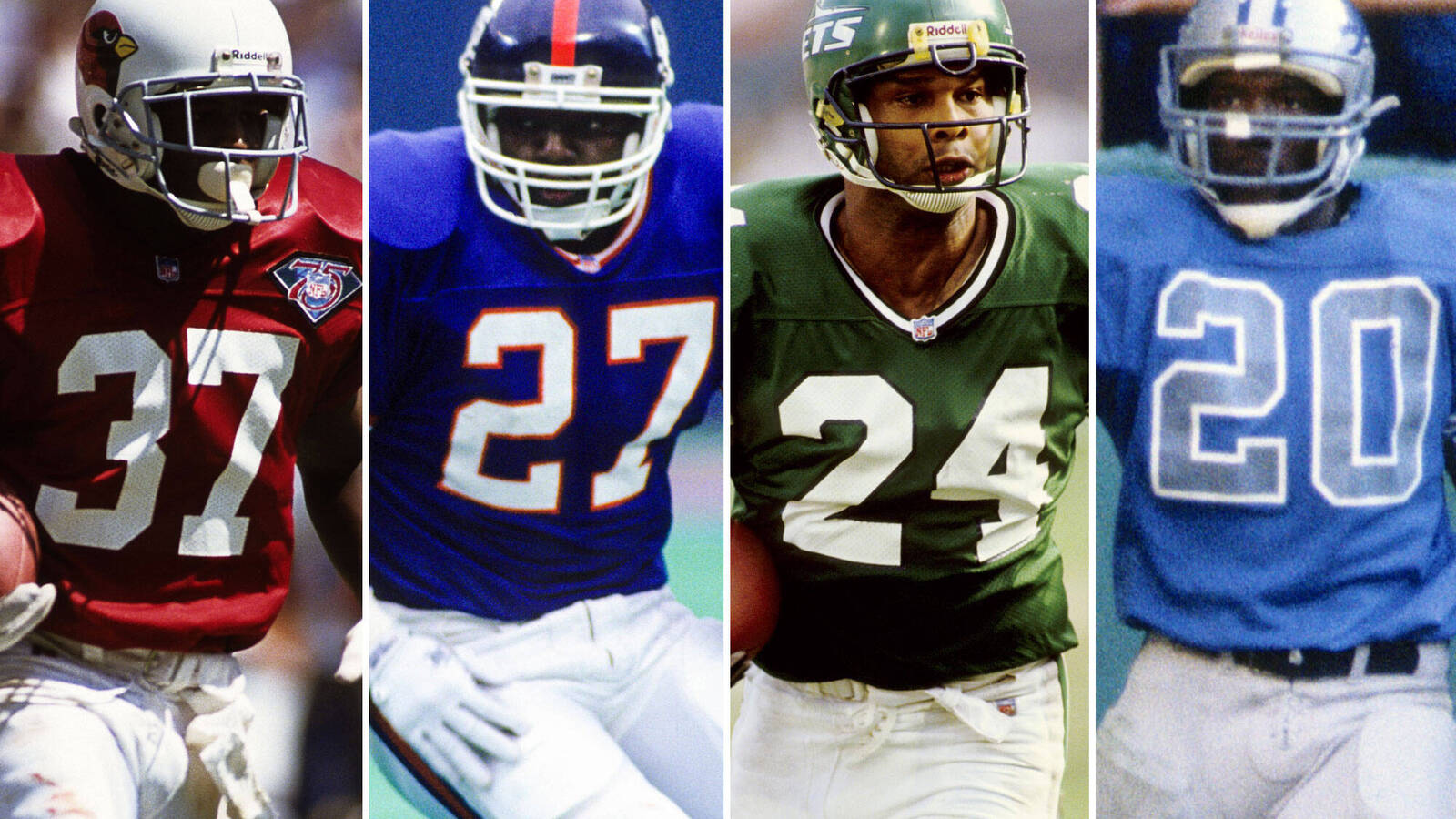
 +
+
